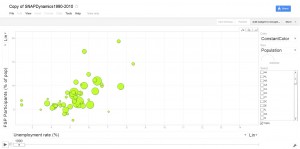I’ve been unemployed for just one month, and already I’ve sent my only child to school crying because other kids make fun of him for being on the free lunch program, driven away from a fender bender with a parked car because I didn’t have the money to pay for the accident (luckily no one was around), been fired from my temp job for talking to a union organizer, put my kid’s dog to sleep because we couldn’t afford its medical care, and applied for food stamps — which won’t arrive until next month.
I’m not proud of myself, but this is what it takes to survive as a poor person in America — and now I know, because I played the game Spent, designed by Jenny Nicholson, herself once a child who grew up in poverty.
This is Christopher Mims discussing the game interactive presentation Spent in a post over at Technology Review. You can play Spent for free by clicking here. You might even be surprised at the very difficult choices poor Americans have to make every month.
The game is sponsored by the Urban Ministries of Durham, which provide food, clothing, and shelter to Durhamites in need.
(HT: Raul Pacheco-Vega.)
